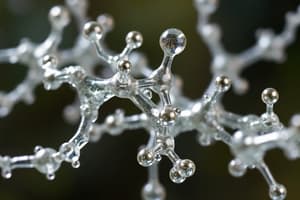Podcast
Questions and Answers
Which of the following characteristics is NOT a defining feature of life?
Which of the following characteristics is NOT a defining feature of life?
- Composed of cells
- Grow and develop
- Maintain competition (correct)
- Reproduce
Which of the following elements is NOT considered an organic element essential for life?
Which of the following elements is NOT considered an organic element essential for life?
- Hydrogen (H)
- Oxygen (O)
- Sodium (Na) (correct)
- Carbon (C)
What is the primary structure of proteins primarily determined by?
What is the primary structure of proteins primarily determined by?
- Formation of peptide bonds
- Sequence of amino acids (correct)
- Overall 3D shape of the protein
- Hydrogen bonds between the side chains
Which of the following processes involves the addition of water to break down macromolecules?
Which of the following processes involves the addition of water to break down macromolecules?
Which of the following describes a saturated fatty acid?
Which of the following describes a saturated fatty acid?
Flashcards
Homeostasis
Homeostasis
The ability of an organism to maintain a stable internal environment, despite changes in the external environment.
Polymer
Polymer
A large molecule made up of repeating smaller units called monomers.
Dehydration Synthesis
Dehydration Synthesis
A chemical reaction that removes a water molecule to join two monomers together.
Hydrolysis
Hydrolysis
Signup and view all the flashcards
Amphipathic
Amphipathic
Signup and view all the flashcards
Study Notes
Main Components of Life
- Seven characteristics of life:
- Composed of cells
- Maintain homeostasis
- Grow and develop
- Reproduce
- Respond to external stimuli
- Evolve
Chemistry of Biology
-
Atoms: Smallest unit of an element
-
Elements: Substances bonded with other elements to form molecules
-
Protons (+): Atomic number = number of protons
-
Neutrons (0): Atomic mass - protons = neutrons
-
Electrons (-): Electrons = protons
-
Electron shells: First shell = 2, Second shell = 8, Outermost shell = filled
-
Organic elements: Carbon (C), Oxygen (O), Nitrogen (N), Hydrogen (H)
Four Major Macromolecules
- Carbohydrates:
- Monomer: Monosaccharides (e.g., glucose)
- Function: Energy storage, main function
- Lipids:
- Monomer: Fatty acids and glycerol
- Function: Energy storage, insulation
- Types: Saturated, unsaturated, phospholipids
- Proteins:
- Monomer: Amino acids
- Function: Structure, enzymes, transport
- Types: Primary, secondary, tertiary, quaternary
- Nucleic Acids:
- Monomer: Nucleotides
- Function: DNA and RNA store genetic information
- Types: DNA, RNA.
Bonds
- Ionic bonds: Transfer of electrons
- Covalent bonds: Sharing of electrons
- Hydrogen bonds: Weak bonds between molecules/parts of molecules
- Polarity: Difference in electronegativity results in polar (unequal sharing) or nonpolar (equal sharing)
Studying That Suits You
Use AI to generate personalized quizzes and flashcards to suit your learning preferences.




